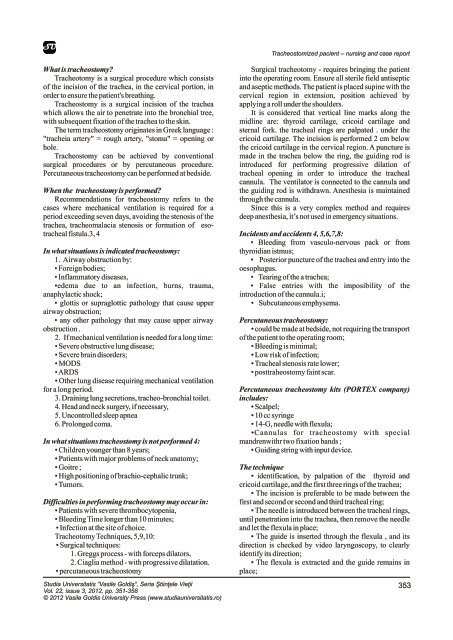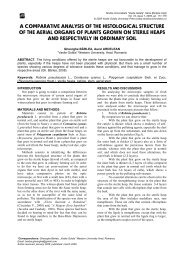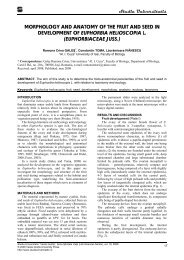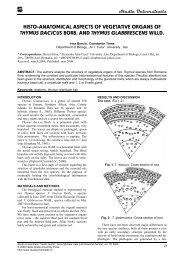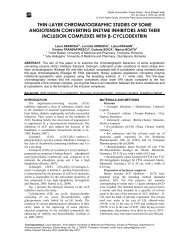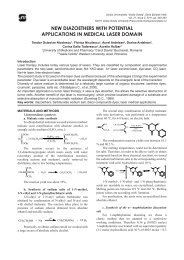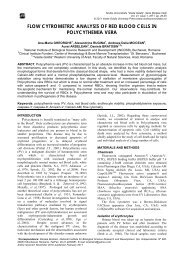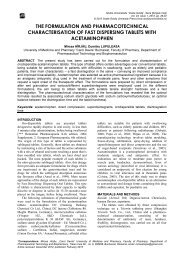Stana 1 - Studia Universitatis Vasile Goldis, Seria Stiintele Vietii
Stana 1 - Studia Universitatis Vasile Goldis, Seria Stiintele Vietii
Stana 1 - Studia Universitatis Vasile Goldis, Seria Stiintele Vietii
You also want an ePaper? Increase the reach of your titles
YUMPU automatically turns print PDFs into web optimized ePapers that Google loves.
What is tracheostomy?<br />
Tracheotomy is a surgical procedure which consists<br />
of the incision of the trachea, in the cervical portion, in<br />
order to ensure the patient's breathing.<br />
Tracheostomy is a surgical incision of the trachea<br />
which allows the air to penetrate into the bronchial tree,<br />
with subsequent fixation of the trachea to the skin.<br />
The term tracheostomy originates in Greek language :<br />
"tracheia artery" = rough artery, "stoma" = opening or<br />
hole.<br />
Tracheostomy can be achieved by conventional<br />
surgical procedures or by percutaneous procedure.<br />
Percutaneous tracheostomy can be performed at bedside.<br />
Surgical tracheotomy - requires bringing the patient<br />
into the operating room. Ensure all sterile field antiseptic<br />
and aseptic methods. The patient is placed supine with the<br />
cervical region in extension, position achieved by<br />
applying a roll under the shoulders.<br />
It is considered that vertical line marks along the<br />
midline are: thyroid cartilage, cricoid cartilage and<br />
sternal fork. the tracheal rings are palpated . under the<br />
cricoid cartilage. The incision is performed 2 cm below<br />
the cricoid cartilage in the cervical region. A puncture is<br />
made in the trachea below the ring, the guiding rod is<br />
introduced for performing progressive dilation of<br />
tracheal opening in order to introduce the tracheal<br />
cannula. The ventilator is connected to the cannula and<br />
the guiding rod is withdrawn. Anesthesia is maintained<br />
through the cannula.<br />
Since this is a very complex method and requires<br />
deep anesthesia, it’s not used in emergency situations.<br />
When the tracheostomy is performed?<br />
Recommendations for tracheostomy refers to the<br />
cases where mechanical ventilation is required for a<br />
period exceeding seven days, avoiding the stenosis of the<br />
trachea, tracheomalacia stenosis or formation of esotracheal<br />
fistula.3, 4 Incidents and accidents 4, 5,6,7,8:<br />
• Bleeding from vasculo-nervous pack or from<br />
In what situations is indicated tracheostomy:<br />
thyroidian istmus;<br />
1. Airway obstruction by: • Posterior puncture of the trachea and entry into the<br />
• Foreign bodies;<br />
oesophagus.<br />
• Inflammatory diseases,<br />
• Tearing of the a trachea;<br />
•edema due to an infection, burns, trauma, • False entries with the imposibility of the<br />
anaphylactic shock;<br />
introduction of the cannula.i;<br />
• glottis or supraglottic pathology that cause upper • Subcutaneous emphysema.<br />
airway obstruction;<br />
• any other pathology that may cause upper airway Percutaneous tracheostomy:<br />
obstruction .<br />
• could be made at bedside, not requiring the transport<br />
2. If mechanical ventilation is needed for a long time: of the patient to the operating room;<br />
• Severe obstructive lung disease;<br />
• Bleeding is minimal;<br />
• Severe brain disorders;<br />
• Low risk of infection;<br />
• MODS<br />
• Tracheal stenosis rate lower;<br />
• ARDS<br />
• posttraheostomy faint scar.<br />
• Other lung disease requiring mechanical ventilation<br />
for a long period.<br />
Percutaneous tracheostomy kits (PORTEX company)<br />
3. Draining lung secretions, tracheo-bronchial toilet. includes:<br />
4. Head and neck surgery, if necessary, • Scalpel;<br />
5. Uncontrolled sleep apnea • 10 cc syringe<br />
6. Prolonged coma. • 14-G, needle with flexula;<br />
•Cannulas for tracheostomy with special<br />
In what situations tracheostomy is not performed 4: mandrenwithr two fixation bands ;<br />
• Children younger than 8 years;<br />
• Guiding string with input device.<br />
• Patients with major problems of neck anatomy;<br />
• Goitre ;<br />
The technique<br />
• High positioning of brachio-cephalic trunk; • identification, by palpation of the thyroid and<br />
• Tumors.<br />
cricoid cartilage, and the first three rings of the trachea;<br />
• The incision is preferable to be made between the<br />
Difficulties in performing tracheostomy may occur in: first and second or second and third tracheal ring;<br />
• Patients with severe thrombocytopenia,<br />
• The needle is introduced between the tracheal rings,<br />
• Bleeding Time longer than 10 minutes;<br />
until penetration into the trachea, then remove the needle<br />
• Infection at the site of choice.<br />
and let the flexula in place;<br />
Tracheotomy Techniques, 5,9,10:<br />
• The guide is inserted through the flexula , and its<br />
• Surgical techniques:<br />
direction is checked by video laryngoscopy, to clearly<br />
1. Greggs process - with forceps dilators, identify its direction;<br />
2. Ciaglia method - with progressive dilatation. • The flexula is extracted and the guide remains in<br />
• percutaneous tracheostomy<br />
place;<br />
<strong>Studia</strong> <strong>Universitatis</strong> “<strong>Vasile</strong> Goldiş”, <strong>Seria</strong> Ştiinţele Vieţii<br />
Vol. 22, issue 3, 2012, pp. 351-358<br />
© 2012 <strong>Vasile</strong> <strong>Goldis</strong> University Press (www.studiauniversitatis.ro)<br />
Tracheostomized pacient – nursing and case report<br />
353


